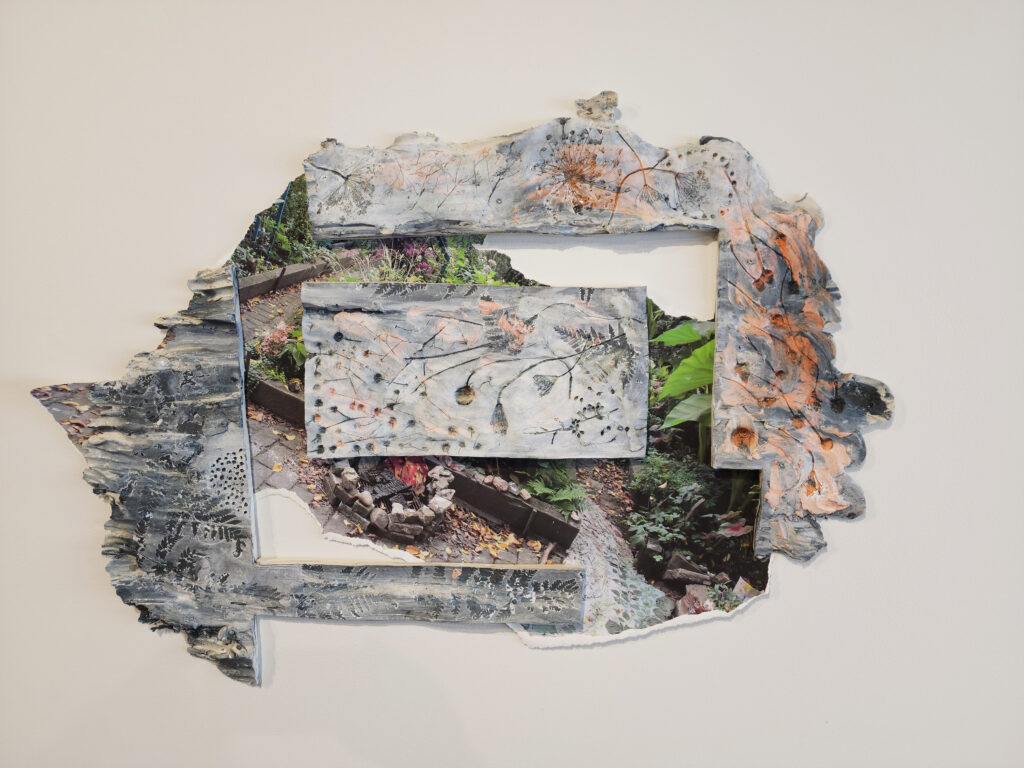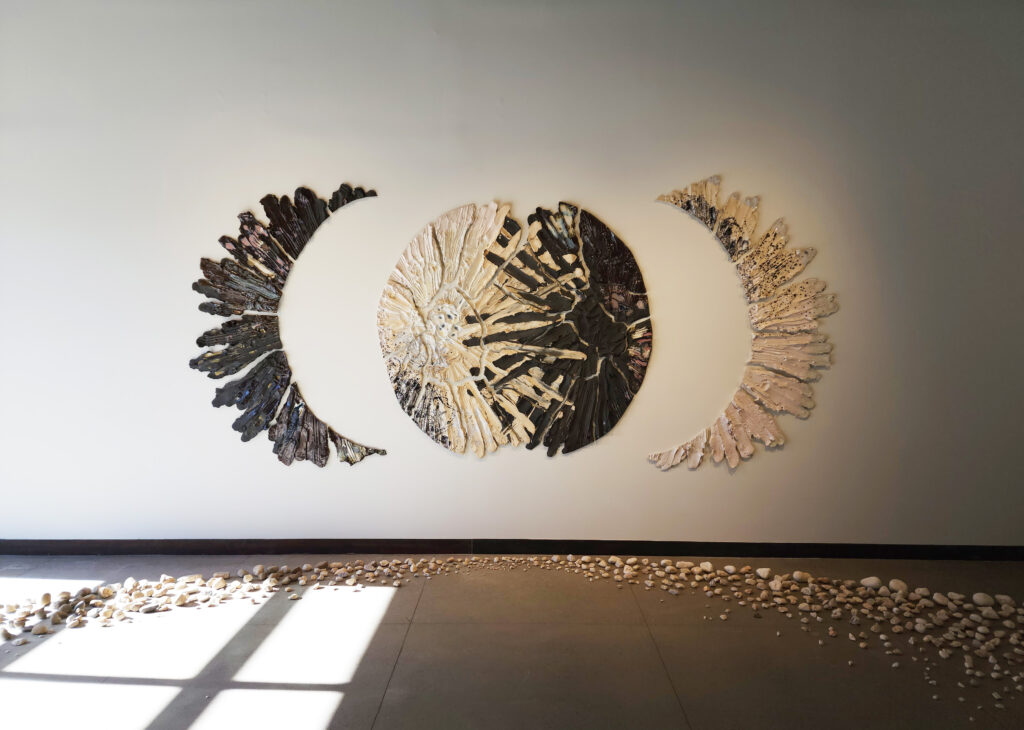You could step on a piece of New Mexico-based artist Brie Ruais’ work and break it in a moment. In Oneness, Ruais’ new solo exhibition at upper Lawrenceville’s Contemporary Craft, the ceramicist and textile artist puts a great deal of trust in viewers. She speckles the floors with pebbles and stones and expands her clay pieces off of the walls and into the show space. The whole collection is a gesture of relational trust—ceramic work always exposes how fragile the intimacy of artists and visitors are.

Brie Ruais, In the Space Between the Parcels (Brooklyn Backyard Garden), 2019
Brie Ruais’ Journey to Contemporary Craft
Ruais learned some of her ability to work three-dimensionally from the best given that she worked in artist Sarah Sze’s (of the Guggenheim’s 2023 Timelapse exhibition) studio for ten years. Her Pittsburgh debut, sponsored by the Tomayko Foundation as part of the Tomayko Solo Elevation Series, shows that Ruais’ sense of space, interest in the natural world, and deep understanding of material come together to create a cohesive and thought-provoking show.
Contemporary Craft is a facility that was once a factory for trophies and award plaques and it now offers a wide, naturally lit gallery space for the artists it showcases. The light from the windows at the gallery makes Ruais’ glazes and underglazes shimmer, as it highlights her color palette of sable, beige, blue, and ashy black. Her work invites the viewer to find natural shapes, topography, rivers, even outer space surfaces in it.
“I took a series of trips to the desert and was inspired by the colors, and then I moved to New Mexico because of that inspiration,” Ruais recalled. The only deviations from a southwestern desert color spectrum are a blush-like pink and a deep green in a series inspired by plant life in a garden.
Where paintings often define themselves by the deliberate choices the artist makes, ceramic work has a more organic process. So much of working with clay, like nature itself, is beyond a person’s control. Ruais’ work balances intentionality with a real sense of surrender to the process.

Brie Ruais, Holding on to what is Tumbling, 130lbs (Blue), 2022
The Various Materials of Oneness
One piece in the exhibit called Holding on to what is Tumbling (Blue) (2022), is a swirl of stoneware, glass, hardware, and found rocks. Cracks in the stoneware and fingerprint-like indentations give off a softness, but the swirl culminates in a black shine of glaze.
“I really love the unexpected, alchemical effect that certain kinds of applications have,” Ruais said.
Materials like soda ash and underglaze changed the texture of each surface, and every movement Ruais made with her hands and feet is etched into that texture. “I’m interested in how materials behave, what memories they have, what stories they have,” Ruais said.

Brie Ruais, Topology of a Garden, Northeast, 135 lbs, 2018
Using the Body as Art
A video in the exhibition gives viewers a chance to see Ruais at work, including a visceral nod to performance art when she rolls in a circle of clay naked.
“I’m interested in the object-subject relationship we have with our bodies, and that shows up in my work. You have a body, but you also are a body in the world,” she said. “And I was experimenting with the ways that form could emerge from action with clay. I wanted there to be a true exchange, a relationship between me and the material. I like a lot of performance art from the ‘70s, and the body is a tool. The body is the material. So I scaled up to my body weight in clay.”
The weight in clay of each piece was an important component of Oneness. Ruais considered the weight of an individual, or the weight of two bodies together, and measured out the clay accordingly.

Brie Ruais, Phasing Eclipse of two Celestial Bodies, 2023
Two Become One
For The Phasing Eclipse of Two Bodies, Ruais wanted to explore “how two bodies coming together creates a third space.” That installation sits on Contemporary Craft’s far wall, two black starbursts colliding with each other and an installation of stones and leftover clay from previous pieces on the floor.
“With a solar eclipse, it’s the sun, the moon, and the Earth coming together, but there’s also you as the witness—that’s what I wanted to put the works on the floor to represent,” Ruais said. The black and white of the piece brings to mind Hilma af Klint’s Group IX/SUW, The Swan, No. 1 (1915), another work interested in how seemingly opposite forces can come together to create a whole.

(L) Brie Ruais, Unzipped Line and Circle (Black and White), 400 lbs, 2015 (R) Brie Ruais, Unzipped Line and Circle (Raw Color), 400 lbs, 2015
Human Connection Through Space
Winglike shapes flank the two central starbursts, and Ruais drew inspiration from the idea of intimacy inside of a parenthetical. It’s an achievement in the way it brings you into both the vastness of space and the closeness of physical intimacy.
“The moon is something that’s so close, yet so distant,” Ruais said. “And we all have it in common. I was thinking about this a lot when my mother was dying last year, and had dementia—something or someone can be so close and so far. There’s a presence and an absence.”
The Phasing Eclipse of Two Bodies reveals a quality in Ruais’s work: It’s dazzling, both in the word’s colloquial use to mean beauty and its more literal meaning of something extremely bright and blinding, just as an eclipse is. Ruais’ ceramics work pushes what beauty can be, leaning not on the man-made but instead the overwhelming awe that nature inspires and can border on fear. It manages to be both sublime and comforting. Though lingering your eyes on an eclipse for too long is ill-advised, you’ll find yourself wanting to look at Brie Ruais’ work for a long time.
Contemporary Craft is at 5645 Butler Street. Guided tours of Oneness are available March 2, April 6, and May 4, 11:00 AM – 12:00 PM. Oneness is open until May 4, 2024.
Story and Photography by Emma Riva
Subscribe to TABLE Magazine’s print edition.

